Behavioral Segmentation: The Key to Understanding Customers
Learn what behavioral segmentation is, how it can provide valuable insight into the customer journey, and how to optimize it.
Originally Published on March 20, 2023
Browse by category
Behavioral segmentation is a vital method for customer segmentation used by businesses that truly want to understand and reach their target audiences. Understanding customers’ behavior patterns by focusing on their actions provides crucial insights that will help businesses improve the purchasing process. These changes will ultimately harness greater customer loyalty and retention.
The marketing and sales landscape has changed drastically over the last few years. Marketing campaigns that cast wide nets by using traditional techniques such as newspaper advertising just don’t work anymore. Customers have come to expect highly targeted marketing efforts that deliver personalized experiences.
Key takeaways
- Businesses use behavioral segmentation to understand what is valuable to their customers and how to target them effectively through hyper-personalization.
- Behavioral segmentation relies on first-party data as opposed to demographic segmentation, which is built on third-party data.
- Behavioral segmentation centers around how your customer journey affects customer actions. Psychographic segmentation looks at customer traits and analyzes the likelihood of conversion based on those traits.
- Geographic segmentation is easy to do with readily available data, but it might not be relevant to all businesses.
- Behavioral segmentation is best utilized to understand the strengths and weaknesses of your customer journey.
- There are five common types of behavioral segmentation—purchase, usage, occasion and timing-based, benefit, and loyalty-based.
What is behavioral segmentation?
Behavioral segmentation is a type of market segmentation in which target audiences are identified based on the actions they take when using a product. Behavioral market segmentation splits customers by usage behaviors such as on-page or CTA clicks, sharing of content on social media, cart abandonment, and purchasing behavior. Behavioral data yields powerful information about what customers value.
Some of the benefits of behavioral segmentation include:
- Personalization—segmenting customers by behavior provides marketing teams with valuable insights. These insights allow them to design and implement a behavioral marketing strategy that delivers highly personalized messages through the channels most likely to reach their target audience.
- Prioritization—grouping customers by behaviors makes it possible to prioritize those with the highest customer lifetime value. Focusing on these customers is the most cost-effective way to allocate budget and resources.
- Forecasting—studying different customer personas’ behavioral patterns in real time makes it easy to identify trends and develop marketing messages and outreach activities in the future.
Here’s an example of behavioral segmentation in action. The funnel analysis below shows the customer journey from landing on the main web page to completing a purchase for an ecommerce app.
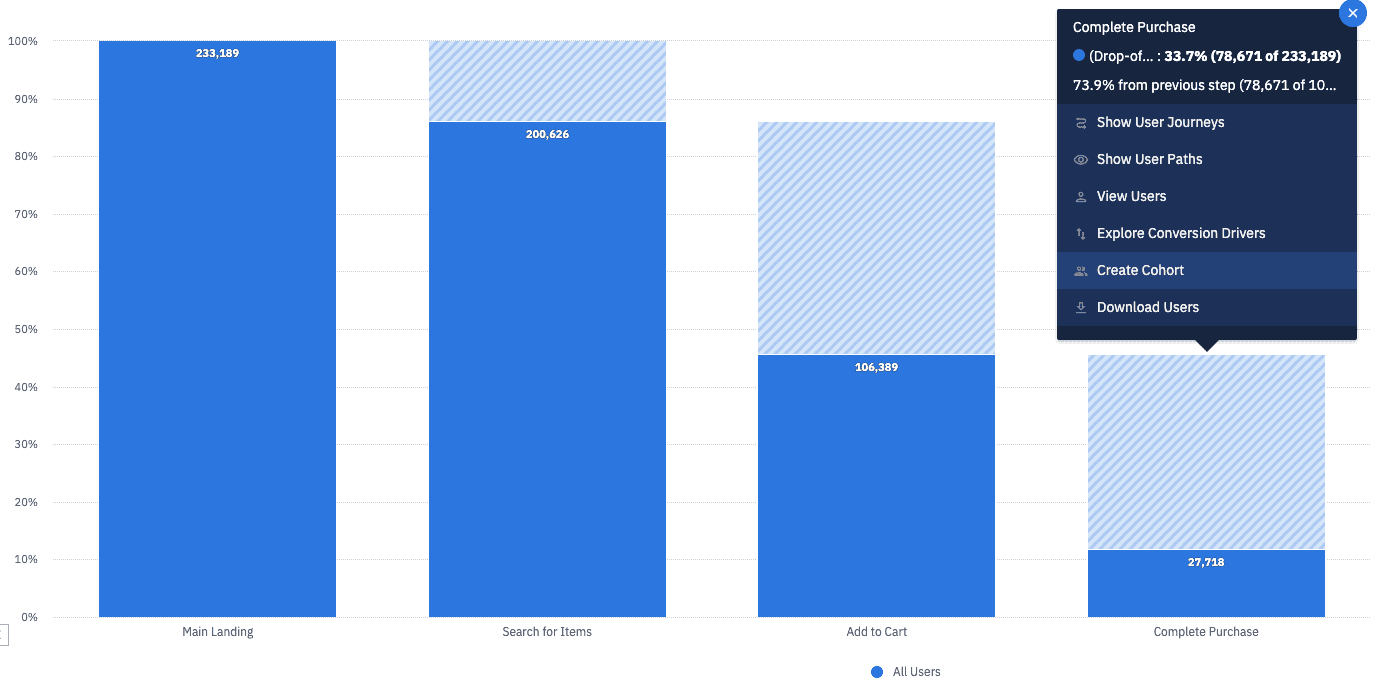
You can use behavioral segmentation to build a segment (or cohort) for users who did not complete a purchase.
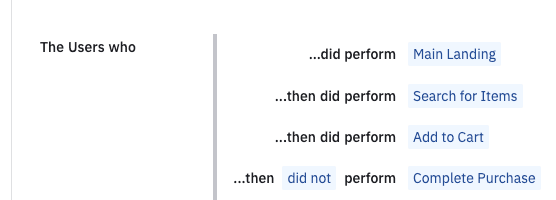
Sync that segment to a downstream destination, like Facebook ads, to send personalized advertising to help them convert.

Behavioral vs. demographic segmentation
Demographic segmentation is a market segmentation process that splits customers into cohorts based on demographic data. This includes factors such as age, gender, level of education, and household income. While behavioral segmentation relies on first-party data, demographic segmentation draws on third-party data.
Demographic segmentation can help with things like pricing a product to fit demographic segments based on income, but it doesn’t say much about customers’ needs and pain points. Behavioral segmentation is more effective when it comes to observing the customer’s experience when interacting with a business—identifying loyal customers in order to reduce churn and increase customer satisfaction.
Behavioral vs. psychographic segmentation
Psychographic segmentation refers to the organization of a customer base according to the psychological traits that impact their interactions with a business, such as purchase decisions or brand loyalty.
Traits that companies normally base their psychographic segmentation on include:
- Personality
- Lifestyle
- Political beliefs
- Hobbies
The two segmentation strategies differ in their purpose. Psychographic segmentation offers insight into why customers make the choices they do based on their internal traits. Behavioral segmentation looks at things from the other end of the spectrum. It analyzes how your product and the customer journey stages impact customer choices.
Psychographic segmentation might link a lifestyle product, like hiking boots, to audiences with a taste for adventure. Behavioral segmentation, on the other hand, might present cross-selling opportunities for products, like instant tents, to customers who have already bought those hiking boots.
Behavioral vs. geographic segmentation
Geographic segmentation divides customers based on their physical location using information like zip code, state, time zone, language, city, and country. Different geographic locations tend to have different characteristics, and this type of segmentation allows businesses to capitalize on them.
The major appeal of geographic segmentation is that it’s easy to implement since, usually, geographic information is readily available. This allows companies to reach potential customers relatively quickly using location-based marketing efforts.
Geographic segmentation might not be relevant for all businesses, though. Some companies sell products or services that are not affected by location-specific nuances. This is particularly true of SaaS solutions like project management tools.
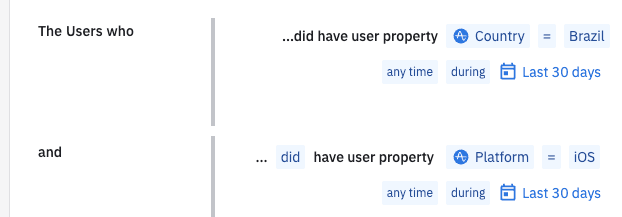
When to utilize behavioral segmentation
Behavioral segmentation is best used to understand the areas of strength and friction across all touchpoints throughout the customer journey. It is a great way to uncover key truths about the way customers engage with a product and answer questions like:
- What behaviors take people from prospective to new customers?
- Which email marketing messages have the highest conversion rates?
- How effective are loyalty programs at converting light users into heavy ones?
- What steps do heavy users take before completing a purchase?
- When do purchases spike and how can identifying those spikes be used to upsell more products?
- Who are the most loyal customers and what would help retain them?
Behavioral segmentation unlocks opportunities at every stage of the customer lifecycle, offering a powerful way to enhance marketing strategies that optimize the user experience and drive engagement.
Behavioral segmentation tools
Access to a wealth of metrics and customer data is vital to behavioral segmentation. Collecting this data manually can be tricky and time-consuming, and can still result in limited information.
Segmentation software like Amplitude Audiences offers direct access to the data required to carry out behavioral segmentation and reap its benefits. These tools can:
- Define dynamic audience segments—gather information on customer behaviors, product data, and profile data, and automate the building of audience lists.
- Compute customer properties in real time—segment users based on behaviors or combinations of behaviors. Such properties include things like average order value, subscription to rewards programs, and last item viewed.
- Predict the best audience to target—design targeted and personalized marketing campaigns. Surface special offers to potential customers, campaigns to keep high lifetime value customers engaged, and messaging to convert on-the-fence prospects into shoppers.
- Centralize and standardize audiences—create automated syncs to any tool for groups of customers for reliability, consistency, and repeatability.
Segmentation tools utilize machine learning algorithms to boost the efficiency of the segmentation process, as well as optimize sales and marketing endeavors.
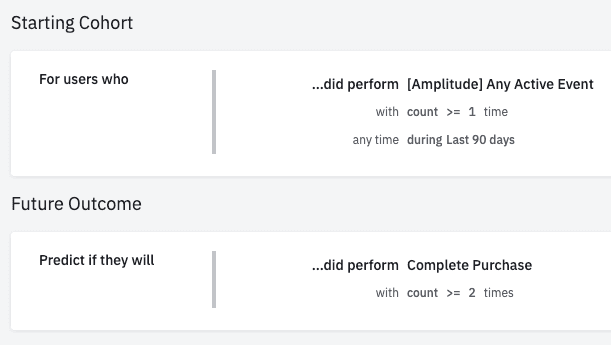

The 5 Types of behavioral segmentation
Behavioral segmentation comes in various forms. Below are five types of behavioral segmentation that are commonly used to shed light on the journey customers take.
1. Purchase segmentation
A popular example of behavioral segmentation involves studying the different behavior patterns of customers before making a purchase. This includes identifying any obstacles as well as incentives throughout the process.
Some customers leave an item in their cart for over a day before making a purchase. Others might only ever purchase during sales and discount periods. Purchase segmentations help reveal such patterns as:
- The number and type of interactions a visitor has with a business before converting into a customer
- The search terms a customer normally uses before coming across a product or service
- The sort of questions a prospective customer asks customer care or chatbots before deciding to make a purchase
This information is critical to making the necessary changes across touchpoints to increase the likelihood of someone making a purchase. For example, if customers tend to seek social proof before buying a product, choosing to make reviews visible on the product page can help get them to click “buy.”
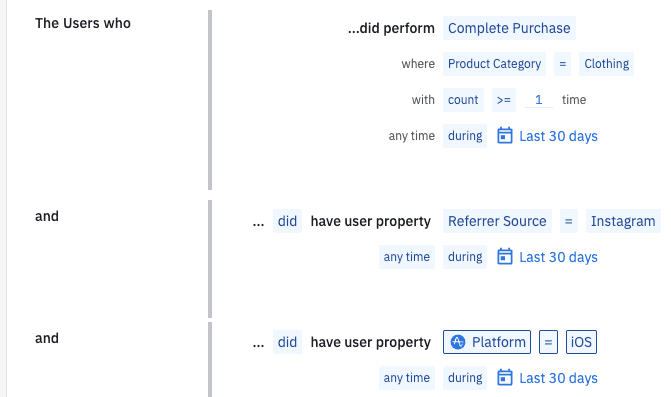
2. Usage segmentation
Monitoring customer usage helps identify heavy users. Simply put, these are the customers who are making purchases often and at higher values. Needless to say, segmenting and targeting these customers often is good for business.
But there’s no need to stop there. It’s useful to know who light and medium users are, too. A sizable customer base of light users could, with more personalized marketing efforts, be upgraded to medium users.
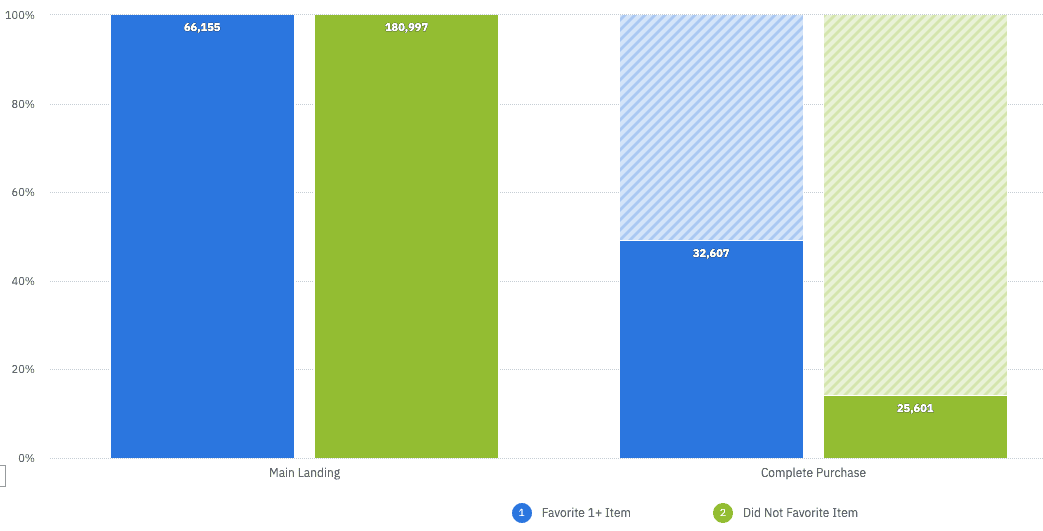
3. Occasion and timing-based segmentation
This type of segmentation reveals when specific customers are most likely to make a purchase. These could be for special occasions or, with some products, certain times of the day, week, or month.
Occasion-based purchases could happen on national holidays and during holidays like Valentine’s Day, Halloween, or Christmas. A large cohort of customers may only purchase gifts for events like birthdays, Christmas, or Valentine’s Day.
Timing-based purchases could be linked to rituals such as customers who order meals from delivery apps for workplace lunches.
This type of segmentation requires constant monitoring and identifying purchasing patterns over time.
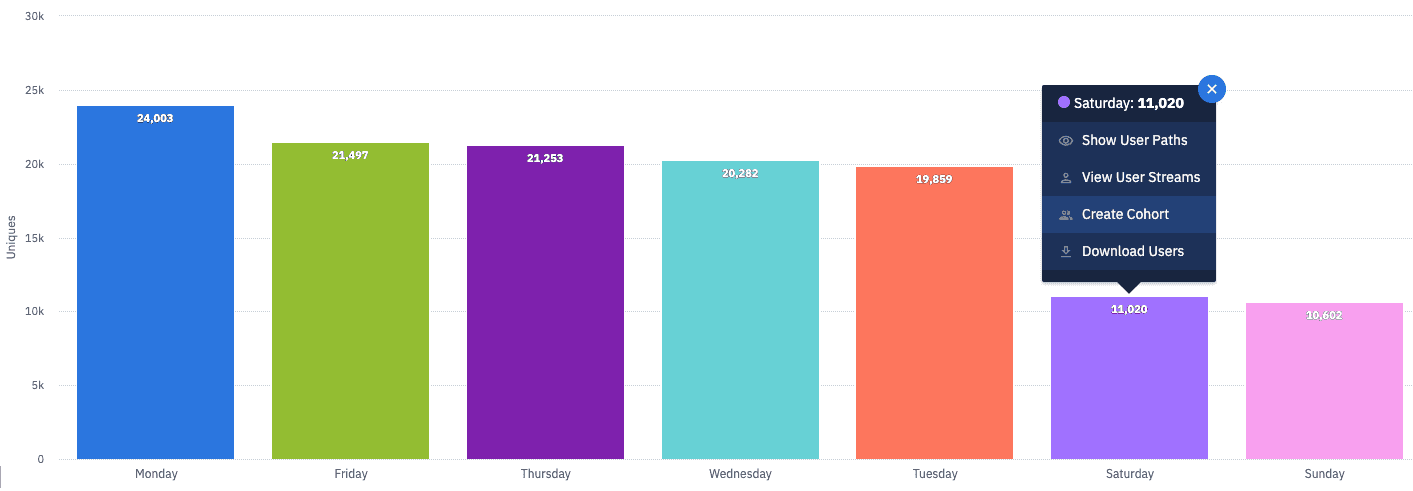
4. Benefit segmentation
Businesses put their products out into the world because they believe they will make their customers’ lives better. Their products’ value propositions include a number of great benefits, and different customer segments might be more interested in one than another.
For instance, some customers may purchase a moisturizer for its anti-aging properties, while others like its high SPF ratings. Others may simply like how it feels on their face.
Grouping customers based on the benefits they’re seeking could help target them more effectively.

5. Loyalty-based segmentation
Loyal customers are the holy grail for any business. After all, research shows that businesses are much more likely to sell to existing customers than to new ones. Loyal customers also help bring in new customers through referrals and word of mouth.
Metrics such as frequency of purchases, average purchase or order value, and subscriptions to reward programs are all measures of loyalty. Understanding why customers are loyal is vital to creating the conditions that will boost loyalty among all customers.
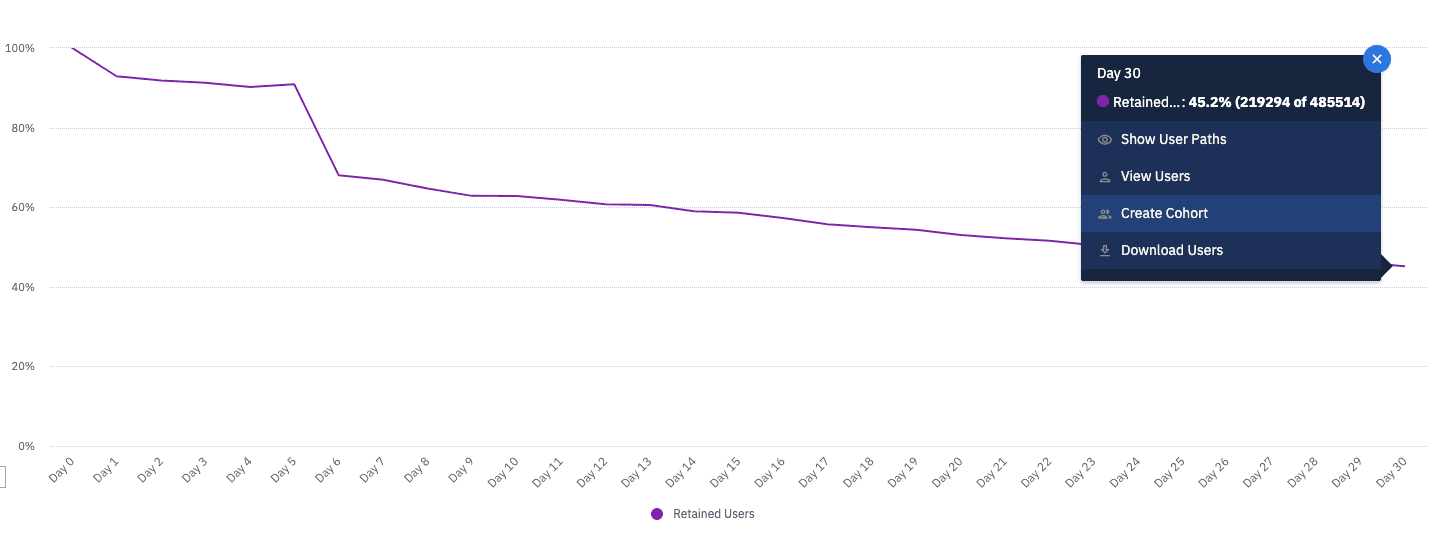
Loyalty-based segmentation is key to understanding users, including:
- What behaviors led to loyalty
- Which customers are most likely to become loyal
- What factors have helped retain loyal customers
- How to maximize the value of loyal customers
Getting started with segmentation
Behavioral segmentation offers a powerful way to personalize marketing and sales efforts, driving retention and revenue. Get started with your own behavioral segmentation initiatives with Amplitude’s free plan.
References

Darshil Gandhi
Director, Product Marketing, Amplitude
Darshil Gandhi is a Director of Product Marketing at Amplitude. He leads global technical and partner product marketing, collaborates with product and go-to-market teams on strategy, positioning, messaging, campaigns, and enablement. He was previously a solutions consulting team principal at Amplitude, and has helped dozens of Amplitude customers turn their data into actionable insights. Darshil graduated from Dartmouth College with a Masters in Engineering Management.
More from Darshil





